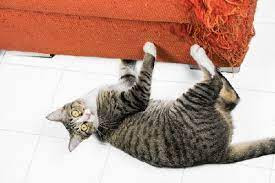Discovering that your cat has turned your new sofa into shreds or left deep scratches on your freshly painted door frames can be disheartening. Dealing with cats scratching furniture can be a genuine challenge, especially if you take pride in your home's appearance. While it may appear that your cat is intentionally causing trouble, it's crucial to understand that scratching is a deeply rooted instinct in cats and serves several purposes that contribute to their overall health and well-being.
Why is your cat scratching carpet and furniture?
Although it may appear that your cat is on a mission to destroy your belongings, there are valid reasons behind their scratching behavior. Firstly, scratching serves as a comprehensive exercise for your cat, stretching their muscles and tendons from their claws to their back.
When your cat scratches the carpet, it's not an attempt to annoy you. Cats have scent glands in their paws, and by scratching objects, they release visible and chemical scent markers that establish their territory within the home. They are more likely to target prominent and frequently used areas such as carpets, sofas, or even your favorite armchair. By scratching these areas, they feel more secure and alleviate stress by marking their scent on objects, creating a sense of familiarity and comfort.
Furthermore, scratching furniture helps cats maintain their claws by shedding the outer sheaths and keeping them sharp. They prefer furniture because of its vertical structure and smooth surfaces, which are ideal for sharpening their claws.
Occasionally, cats may scratch out of boredom, especially if they are house cats lacking sufficient mental stimulation. Now that you understand the reasons behind their behavior, the question remains: How can you prevent cats from scratching furniture?
How to stop cats from scratching furniture?
To prevent cats from scratching furniture, it's essential to offer them appealing scratching alternatives within the house. Just as outdoor cats scratch trees and posts, providing scratching posts indoors is a great way to redirect their behavior and deter them from damaging furniture or carpets.
Choose high-quality scratching trees or posts that are sturdy and stable, ensuring they won't wobble or tip over when your cat uses them. This is important because a shaky post may discourage your cat from using it. Additionally, make sure the scratching posts are tall enough for your cat to fully stretch their body, allowing them to exercise their muscles effectively.
To add variety and keep your cat entertained, you can provide fabric offcuts, bark-covered logs, softwood remnants, or sisal fiber. These options offer different textures and sensations for your cat to enjoy while satisfying their scratching instincts. By offering these fun and easily accessible scratching objects, your cat is less likely to target your furniture.
Remember to place the scratching posts or alternative objects in strategic locations where your cat tends to scratch furniture. This will encourage them to choose the designated scratching areas instead, effectively redirecting their scratching behavior.
With these appropriate scratching options available, your cat will have a satisfying and enjoyable outlet for their natural instincts, while your furniture remains protected.
Strategic placement is key
When it comes to preventing cats from scratching furniture, the placement of scratching posts and objects is crucial. Position them in areas where your cat already likes to relax or near items they typically scratch, such as the arm of the sofa. It's also a good idea to place them near your cat's sleeping spots, as they often enjoy a good stretch and scratch upon waking up.
Encourage interest
If your cat doesn't show immediate interest in the scratching post, consider options that include a dangling toy to attract their attention. You can also try sprinkling some catnip on or near the post to entice them. Catnip has a stimulating effect on most cats and can make the scratching post more enticing.
Put an end to repeat offenses
To prevent cats from repeatedly scratching furniture, it's important to thoroughly clean the areas they have targeted to remove their scent markings. Cats are more likely to scratch in areas where they can detect their own scent fading, as they are motivated to "refresh" it. Use a mild and non-toxic cleaning solution that is appropriate for the material, and keep your cat away from the area until it is fully dry.
Combat boredom scratching
If your cat scratches furniture out of boredom or due to a lack of exercise, consider investing in some cat toys or kitten toys. Schedule regular playtime sessions with your cat to provide mental stimulation and physical activity. There is a wide range of cat toys available, from electronic mice to teaser wands, so you can find options that your cat will love and keep them entertained.
By strategically placing scratching posts, encouraging interest, preventing scent marking, and addressing boredom, you can effectively redirect your cat's scratching behavior and protect your furniture.


.jpg)
.jpg)
